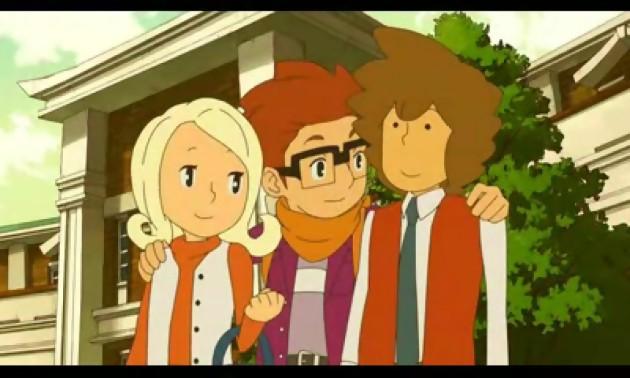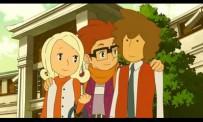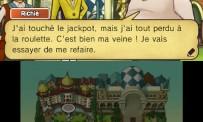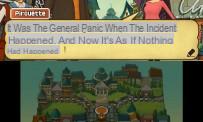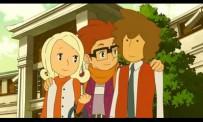 Called upon like a Batman in a top hat in the party town of Dorémont, Hershel Layton responds to the request for help from a very old friend, Marissa. His adopted city has been under attack for several days by a certain Master of the Mask, a magician wearing the legendary Mask of Chaos. An artifact intimately linked to the Professor's adolescence, a period during which the search for this mythical piece led one of his relatives to a tragic fate. Already turned towards a more melancholic atmosphere for two episodes, the series of Level-5 continues its turn in the emotion with a story which still exposes Layton in a different light. More carefree and open in the past, displaying this mixture of kind coldness and wry gaze in the present. A character who takes on a real depth in a space that lets him express himself fully. Even if Luke and Emmy act as effective sidekicks, whose ease in defusing delicate situations with humor or too much seriousness demonstrates the writing talent that emanates from this Professor Layton and the Mask of Miracles. A rhythmic whole, at least after a sluggish opening, rich in feelings, which creates attachment on a now very refined material. A comfort in the immersion which is based on the finely worked impression of participating in an anime, especially helped by the sequences produced by Production IG A coating which is not likely to be segmenting as communicators like to repeat, both the Level-5's game is thoughtful for a wide audience, both in its good nature and in its operation. And this even if the surprises have stopped being desired for a long time.
Called upon like a Batman in a top hat in the party town of Dorémont, Hershel Layton responds to the request for help from a very old friend, Marissa. His adopted city has been under attack for several days by a certain Master of the Mask, a magician wearing the legendary Mask of Chaos. An artifact intimately linked to the Professor's adolescence, a period during which the search for this mythical piece led one of his relatives to a tragic fate. Already turned towards a more melancholic atmosphere for two episodes, the series of Level-5 continues its turn in the emotion with a story which still exposes Layton in a different light. More carefree and open in the past, displaying this mixture of kind coldness and wry gaze in the present. A character who takes on a real depth in a space that lets him express himself fully. Even if Luke and Emmy act as effective sidekicks, whose ease in defusing delicate situations with humor or too much seriousness demonstrates the writing talent that emanates from this Professor Layton and the Mask of Miracles. A rhythmic whole, at least after a sluggish opening, rich in feelings, which creates attachment on a now very refined material. A comfort in the immersion which is based on the finely worked impression of participating in an anime, especially helped by the sequences produced by Production IG A coating which is not likely to be segmenting as communicators like to repeat, both the Level-5's game is thoughtful for a wide audience, both in its good nature and in its operation. And this even if the surprises have stopped being desired for a long time.Professor Layton natural
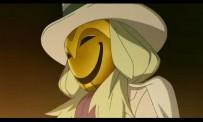 Professor Layton and the Mask of Miracles is aptly named. Because the miracle is indeed there, on the side of the 3D wheel of the Nintendo 3DS that some thought they would never touch again. In the desire to use the platform on which its title is developed, Level-5 has allowed itself the little madness to offer depth management which sometimes highlights important elements and helps to find places to press. inspection to take advantage of the new "zoom" feature. An effect that takes part in an overall muscular awakening of the game, which finally has some animation in the investigation and exploration phase with a pleasant pivoting movement when the magnifying glass scans the screen in search of clues . A pointer which is also tinged with blue as soon as it is possible to circumvent an obstacle in the foreground in order to see what is happening behind. A smooth transition that most often leads to the discovery of the famous SOS coins or rare objects, adding to a list of treasures to unearth in the darkest corners of Dorémont and other towns. Leaving the old-fashioned 2D for a surplus of thickness with real pieces of polygons, Professor Layton and the Mask of Miracles never loses its DNA and recalls it with an almost unchanged structure. As frightening as it may seem, the people encountered in the streets that the Professor crosses always have this OCD that prompts them to propose a riddle to the first guy in a top hat. Whether solving the problem of two ladybugs lost on an ear of corn or that of fixing a broken tile, the inhabitants of this complex world assail the player with puzzles, cheerfully pushing the number of the 150 mysteries available in part of the adventure.
Professor Layton and the Mask of Miracles is aptly named. Because the miracle is indeed there, on the side of the 3D wheel of the Nintendo 3DS that some thought they would never touch again. In the desire to use the platform on which its title is developed, Level-5 has allowed itself the little madness to offer depth management which sometimes highlights important elements and helps to find places to press. inspection to take advantage of the new "zoom" feature. An effect that takes part in an overall muscular awakening of the game, which finally has some animation in the investigation and exploration phase with a pleasant pivoting movement when the magnifying glass scans the screen in search of clues . A pointer which is also tinged with blue as soon as it is possible to circumvent an obstacle in the foreground in order to see what is happening behind. A smooth transition that most often leads to the discovery of the famous SOS coins or rare objects, adding to a list of treasures to unearth in the darkest corners of Dorémont and other towns. Leaving the old-fashioned 2D for a surplus of thickness with real pieces of polygons, Professor Layton and the Mask of Miracles never loses its DNA and recalls it with an almost unchanged structure. As frightening as it may seem, the people encountered in the streets that the Professor crosses always have this OCD that prompts them to propose a riddle to the first guy in a top hat. Whether solving the problem of two ladybugs lost on an ear of corn or that of fixing a broken tile, the inhabitants of this complex world assail the player with puzzles, cheerfully pushing the number of the 150 mysteries available in part of the adventure. A comfort in the immersion which is based on the finely worked impression of participating in an anime"
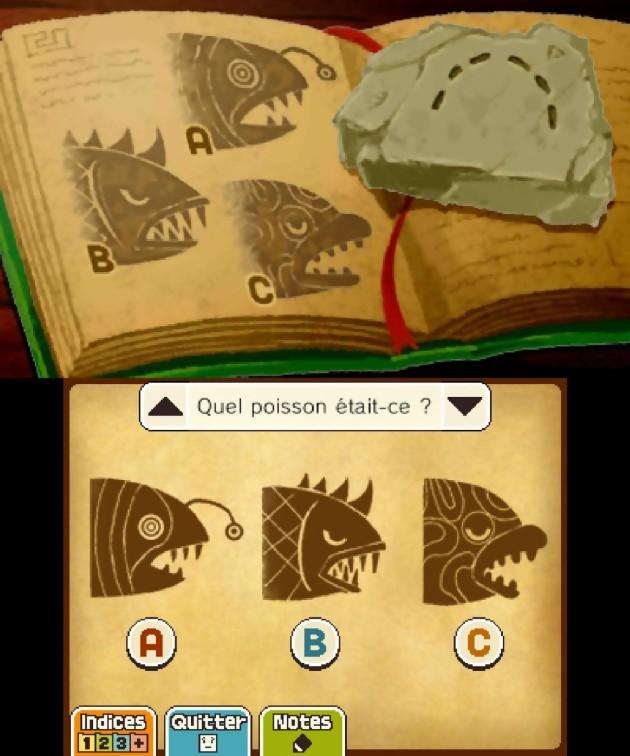 A figure to which must be added the tests to be downloaded day by day free of charge for one year, that is 365 more reasons to put your head under cold water after 30 minutes of intensive reflection. Most often well thought out, the puzzles of Professor Layton and the Mask of Miracles tend to repeat themselves by gradation with more or less alternative versions. No more or less complicated than those of the previous part, they suffer from the same difficulty in renewing themselves sufficiently, especially in terms of the interactions offered. Especially since some statements still suffer from the usual syndrome of the series, a certain lack of indications which opposes the player to an understanding of what he must do more than to the resolution. Nothing really bad in a winning formula, which despite an evolution curve that is more like the highway, still manages to attract by this meeting between the challenge of a puzzle and the pleasure of following a beautiful story. In this, Professor Layton and the Mask of Miracles is like a very comfortable old English armchair. At the risk of becoming a piece of furniture too.
A figure to which must be added the tests to be downloaded day by day free of charge for one year, that is 365 more reasons to put your head under cold water after 30 minutes of intensive reflection. Most often well thought out, the puzzles of Professor Layton and the Mask of Miracles tend to repeat themselves by gradation with more or less alternative versions. No more or less complicated than those of the previous part, they suffer from the same difficulty in renewing themselves sufficiently, especially in terms of the interactions offered. Especially since some statements still suffer from the usual syndrome of the series, a certain lack of indications which opposes the player to an understanding of what he must do more than to the resolution. Nothing really bad in a winning formula, which despite an evolution curve that is more like the highway, still manages to attract by this meeting between the challenge of a puzzle and the pleasure of following a beautiful story. In this, Professor Layton and the Mask of Miracles is like a very comfortable old English armchair. At the risk of becoming a piece of furniture too.